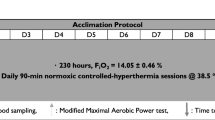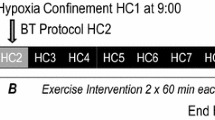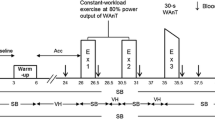Abstract
The effect of acute and 23 days of intermittent exposures to normobaric hypoxia on the forehead sweating response during steady-state exercise was investigated. Eight endurance athletes slept in a normobaric hypoxic room for a minimum of 8 h per day at a simulated altitude equivalent to 2,700 m for 23 days (sleep high–train low regimen). Peak oxygen uptake \( {\left( {\ifmmode\expandafter\dot\else\expandafter\.\fi{V}{\text{O}}_{{2{\text{peak}}}} } \right)} \) and peak work rate (WRpeak) were determined under normoxic (20.9%O2) and hypoxic (13.5%O2) conditions prior to (pre-IHE), and immediately after (post-IHE) the intermittent hypoxic exposures (IHE). Also, each subject performed three 30-min cycle-ergometry bouts: (1) normoxic exercise at 50% WRpeak attained in normoxia (control trial; CT); (2) hypoxic exercise at 50% WRpeak attained in hypoxia (hypoxic relative trial; HRT) and (3) hypoxic exercise at the same absolute work rate as in CT (hypoxic absolute trial; HAT). Exposure to hypoxia induced a 33 and 37% decrease (P < 0.001) in \( \ifmmode\expandafter\dot\else\expandafter\.\fi{V}{\text{O}}_{{2{\text{peak}}}} \) pre-IHE and post-IHE, respectively. Despite similar relative oxygen uptake during HAT pre-IHE and post-IHE, the ratings of perceived whole-body exertion decreased substantially (P < 0.05) post-IHE. Pre-IHE the sweat secretion on the forehead \( {\left( {\ifmmode\expandafter\dot\else\expandafter\.\fi{m}_{{{\text{sw}}}} f} \right)} \) was greater (P < 0.01) in the HAT (2.60 (0.80) mg cm−2 min−1) compared to the other two trials (CT = 1.87 (1.09) mg cm−2 min−1; HRT = 1.57 (0.82) mg cm−2 min−1) despite a similar exercise-induced elevation in body temperatures, resulting in an augmented (P < 0.01) gain of the sweating response \( {\left( {\ifmmode\expandafter\dot\else\expandafter\.\fi{m}_{{{\text{sw}}}} f/\Delta T_{{{\text{re}}}} } \right)}. \) The augmented \( \ifmmode\expandafter\dot\else\expandafter\.\fi{m}_{{{\text{sw}}}} f \) and \( \ifmmode\expandafter\dot\else\expandafter\.\fi{m}_{{{\text{sw}}}} f/\Delta T_{{{\text{re}}}} \) during the HAT were no longer evident post-IHE. Thus, it appears that exercise sweating on the forehead is potentiated by acute exposure to hypoxia, an effect which can be abolished by 23 days of intermittent hypoxic exposures.




Similar content being viewed by others
References
Adams RP, Welch HG (1980) Oxygen uptake, acid-base status, and performance with varied inspired oxygen fractions. J Appl Physiol 49:863–868
Bocqueraz O, Koulmann N, Guigas B, Jimenez C, Melin B (2004) Fluid-regulatory hormone responses during cycling exercise in acute hypobaric hypoxia. Med Sci Sports Exerc 36:1730–1736
Borg GA (1982) Psychophysical bases of perceived exertion. Med Sci Sports Exerc 14:377–381
Bouissou P, Guezennec CY, Defer G, Pesquies P (1987) Oxygen consumption, lactate accumulation, and sympathetic response during prolonged exercise under hypoxia. Int J Sports Med 8:266–269
Calbet JA, Boushel R, Radegran G, Sondergaard H, Wagner PD, Saltin B (2003) Why is VO2 max after altitude acclimatization still reduced despite normalization of arterial O2 content? Am J Physiol Regul Integr Comp Physiol 284:R304–R316
Clark SA, Aughey RJ, Gore CJ, Hahn AG, Townsend NE, Kinsman TA, Chow CM, McKenna MJ, Hawley JA (2004) Effects of live high, train low hypoxic exposure on lactate metabolism in trained humans. J Appl Physiol 96:517–525
Drummond PD, Lance JW (1987) Facial flushing and sweating mediated by the sympathetic nervous system. Brain 110(Pt 3):793–803
Eiken O, Mekjavic IB (2004) Ischaemia in working muscles potentiates the exercise-induced sweating response in man. Acta Physiol Scand 181:305–311
Fulco CS, Rock PB, Cymerman A (2000) Improving athletic performance: is altitude residence or altitude training helpful? Aviat Space Environ Med 71:162–171
Greenleaf JE, Greenleaf J, Card DH, Saltin B (1969) Exercise-temperature regulation in man during acute exposure to simulated altitude. J Appl Physiol 26:290–296
Hogan MC, Cox RH, Welch HG (1983) Lactate accumulation during incremental exercise with varied inspired oxygen fractions. J Appl Physiol 55:1134–1140
Houdas Y, Lecroart JL, Ledru C, Carette G (1979) Thermal sweat rate response to an acute short exposure at a simulated altitude of 4,600 m. Aviat Space Environ Med 50:60–62
Houssiere A, Najem B, Ciarka A, Velez-Roa S, Naeije R, van de Borne P (2005) Chemoreflex and metaboreflex control during static hypoxic exercise. Am J Physiol Heart Circ Physiol 288:H1724–H1729
Juel C, Lundby C, Sander M, Calbet JA, Hall G (2003) Human skeletal muscle and erythrocyte proteins involved in acid-base homeostasis: adaptations to chronic hypoxia. J Physiol 548:639–648
Kacin A, Golja P, Eiken O, Tipton MJ, Gorjanc J, Mekjavic IB (2005) Human temperature regulation during cycling with moderate leg ischaemia. Eur J Appl Physiol 95:213–220
Kato T, Matsumura Y, Tsukanaka A, Harada T, Kosaka M, Matsui N (2004) Effect of low oxygen inhalation on changes in blood pH, lactate, and ammonia due to exercise. Eur J Appl Physiol 91:296–302
Knight DR, Poole DC, Hogan MC, Bebout DE, Wagner PD (1996) Effect of inspired O2 concentration on leg lactate release during incremental exercise. J Appl Physiol 81:246–251
Kolka MA, Stephenson LA, Rock PB, Gonzalez RR (1987) Local sweating and cutaneous blood flow during exercise in hypobaric environments. J Appl Physiol 62:2224–2229
Kondo N, Tominaga H, Shibasaki M, Aoki K, Koga S, Nishiyasu T (1999) Modulation of thermoregulatory sweating response to mild hyperthermia during activation of the muscle metaboreflex in humans. J Physiol 515(Pt 2):591–598
Mekjavic IB, Eiken O (2006) Contribution of thermal and nonthermal factors to the regulation of body temperature in humans. J Appl Physiol 100:2065–2072
Mizuno M, Juel C, Bro-Rasmussen T, Mygind E, Schibye B, Rasmussen B, Saltin B (1990) Limb skeletal muscle adaptation in athletes after training at altitude. J Appl Physiol 68:496–502
Nielsen B (1969) Thermoregulation in rest and exercise. Acta Physiol Scand Suppl 323:1–74
Rowell LB, Brengelmann GL, Savage MV, Freund PR (1989) Does acute hypoxemia blunt sympathetic activity in hyperthermia? J Appl Physiol 66:28–33
Saito M, Mano T, Iwase S, Koga K, Abe H, Yamazaki Y (1988) Responses in muscle sympathetic activity to acute hypoxia in humans. J Appl Physiol 65:1548–1552
Saunders PU, Telford RD, Pyne DB, Cunningham RB, Gore CJ, Hahn AG, Hawley JA (2004) Improved running economy in elite runners after 20 days of simulated moderate-altitude exposure. J Appl Physiol 96:931–937
Seals DR, Johnson DG, Fregosi RF (1991) Hypoxia potentiates exercise-induced sympathetic neural activation in humans. J Appl Physiol 71:1032–1040
Shibasaki M, Kondo N, Crandall CG (2001) Evidence for metaboreceptor stimulation of sweating in normothermic and heat-stressed humans. J Physiol 534:605–611
van Beaumont W, Bullard RW (1966) Sweating exercise stimulation during circulatory arrest. Science 152:1521–1523
van Hall G, Calbet JA, Sondergaard H, Saltin B (2002) Similar carbohydrate but enhanced lactate utilization during exercise after 9 wk of acclimatization to 5,620 m. Am J Physiol Endocrinol Metab 283:E1203–E1213
Vrhovec B, Gorjanc J, Mekjavic IB (2002) Rateče hypoxic room. Med Razgl 41:177–181
Weisbrod CJ, Minson CT, Joyner MJ, Halliwill JR (2001) Effects of regional phentolamine on hypoxic vasodilatation in healthy humans. J Physiol 537:613–621
Xie A, Skatrud JB, Puleo DS, Morgan BJ (2001) Exposure to hypoxia produces long-lasting sympathetic activation in humans. J Appl Physiol 91:1555–1562
Acknowledgments
This study was supported, in part, by grants from the Ministry of Education, Science and Sport, and the Sport Foundation of the Republic of Slovenia to Igor B. Mekjavic. Alan Kacin was recipient of a Young Investigator Postgraduate Fellowship from the Ministry of Education, Science and Sport.
Author information
Authors and Affiliations
Corresponding author
Rights and permissions
About this article
Cite this article
Kacin, A., Golja, P., Eiken, O. et al. The influence of acute and 23 days of intermittent hypoxic exposures on the exercise-induced forehead sweating response. Eur J Appl Physiol 99, 557–566 (2007). https://doi.org/10.1007/s00421-006-0364-9
Accepted:
Published:
Issue Date:
DOI: https://doi.org/10.1007/s00421-006-0364-9




